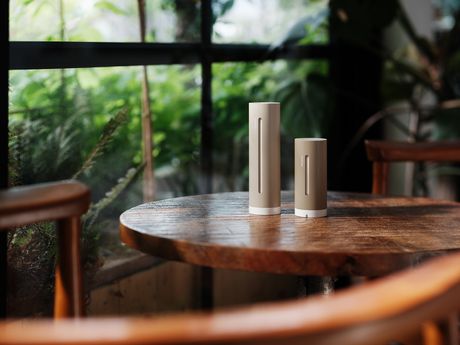
Netatmo dévoile la nouvelle Station Météo ORIGINAL

Jusqu'à -50% sur une sélection de produitsAcheter

Le chauffage au sol ou plancher chauffant se distingue d’un radiateur car il émet de la chaleur en la répartissant dans toutes les pièces de la maison. C’est un système de chauffage au niveau du sol très confortable et pratique développé depuis les années 1960. Depuis, les systèmes de chauffage au sol se sont beaucoup améliorés, notamment au niveau du rendement.
Le système de chauffage au sol, qu’il soit à l’eau ou électrique, fonctionne de manière simple : la chaleur est diffusée dans toutes les pièces de la maison par le sol, de manière uniforme ou selon les réglages programmés. Avec un chauffage au sol hydraulique, une eau à température modérée (40°C) sillonne les tuyaux en polyéthylène qui se trouvent à l’intérieur de la chape de béton, qui retient la chaleur afin de la diffuser sur toute la surface. Avec un chauffage au sol électrique, un câble chauffant diffuse la chaleur par rayonnement et offre un grand confort thermique.
L’objectif du système de chauffage au sol est que la température du sol reste à un niveau correct, c’est à dire agréable même pour y marcher pieds nus. Le sol ne peut dépasser une température de 28°C, ce qui serait considéré comme trop chaud, mais à l’inverse, vous aurez en permanence un sol sur lequel marcher avec plaisir.
Avec le Thermostat Intelligent Netatmo, ajustez la température de votre chauffage au sol directement sur le thermostat ou à distance à l’aide de votre smartphone, tablette ou ordinateur !
Le chauffage au sol électrique ou plancher à rayonnement électrique est le plus courant en France et il n’est constitué que d’un seul câble chauffant. Il couvre l'entièreté du sol des pièces de la maison et il est raccordé au secteur pour pouvoir fonctionner grâce à l’électricité du réseau.
Le plancher chauffant électrique, comme son homologue à eau chaude, transmet une chaleur douce, bien répartie et agréable dans toute la pièce via un effet de rayonnement.
Ce système de chauffage au sol électrique par rayonnement augmente la température de tous les éléments de la maison, du sol au plafond en passant par les murs et les objets. C’est pour cela que le confort est optimal. Son installation simple, rapide et moins onéreuse que le plancher chauffant à eau chaude est fréquente en rénovation.
Un autre type de chauffage au sol rayonnant électrique existe : celui à accumulation ou mixte. Son fonctionnement est très légèrement différent puisqu’il accumule la chaleur émise par inertie pendant le temps de non-utilisation pour la restituer lorsqu’il est allumé.
Ce système de chauffage au sol doit être apparié avec d’autres radiateurs ou d’autres émetteurs de chaleur d’appoint comme des plinthes chauffantes afin de pallier un manque d’énergie accumulée.
Le chauffage au sol à eau ou chauffage au sol hydraulique est un système de chauffage à basse température. Il possède quant à lui tout un réseau de tubes intégrés dans la dalle ou la chape de votre maison. Ils forment un circuit fermé pour fonctionner à la manière d’un circuit de chauffage central classique et produire de la chaleur qui vient faire monter la température de votre maison, mais aussi de votre eau sanitaire !
Pour chauffer à une température faible l’intégralité de la surface du sol des pièces de la maison mais aussi son air intérieur, le chauffage au sol est constitué de tuyaux en polyéthylène installés sur un isolant en polystyrène. Cet ensemble est posé sur la dalle en béton sur laquelle repose la maison et une chape est coulée sur les tuyaux pour le recouvrir.
Le revêtement de sol qui est posé en dernier peut être du carrelage, du parquet, de la pierre, du marbre marqueté ou encore certaines moquettes (selon le DTU du produit).
Plus intéressant encore, le chauffage au sol à eau est réversible et permet en été d’abaisser la température de vos pièces jusqu’à 5 degrés : oui, le plancher chauffant à eau peut jouer le rôle de climatisation !
Plus cher à l’achat et à l’installation, il s’avère cependant plus économique à l'usage que le chauffage au sol électrique. Enfin, notez qu’il peut être associé à plusieurs radiateurs à eau basse température si besoin.
Qu’il soit électrique ou hydraulique, votre chauffage au sol peut gagner en praticité et en efficacité avec le Thermostat Intelligent Netatmo : il peut être installé par un installateur certifié Netatmo en 20 minutes !
Pour calculer le prix d’un chauffage au sol, 3 critères sont à prendre en compte :
Pour un logement neuf, son prix se trouve généralement entre 40 et 120 €/m2 (en incluant le matériel et l’installation). Plus précisément, comptez des prix variant de 70 et 110 € par mètre carré installé pour un plancher chauffant hydraulique et de 40 à 50 € du mètre carré pour un chauffage au sol électrique. Cependant pour des travaux de rénovation, le coût peut être supérieur.
Certaines aides peuvent vous aider à financer votre chauffage au sol :
En résumé, le chauffage au sol est intéressant à bien des égards, notamment pour le confort à l’intérieur des pièces de votre maison grâce à sa chaleur parfaitement diffusée. Mais son coût n’est pas des moindres et il impose certaines contraintes, comme au niveau du revêtement de sol.